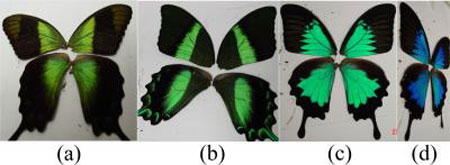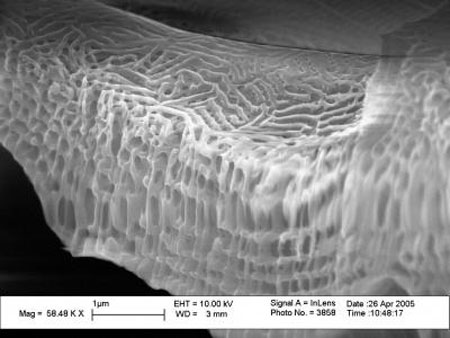| Jul 17, 2013 |
Nature's nanostructures could inspire new hue-changing materials
|
|
(Nanowerk News) Butterfly wings can do remarkable things with light, and humans are still trying to learn from them. Physicists have now uncovered how subtle differences in the tiny crystals of butterfly wings create stunningly varied patterns of color even among closely related species. The discovery, reported today in the Optical Society's (OSA) open-access journal Optical Materials Express ("ridescence and nano-structure differences in Papilio butterflies"), could lead to new coatings for manufactured materials that could change color by design, if researchers can figure out how to replicate the wings' light-manipulating properties.
|
 |
| These are the wings of the three types of butterflies under study. From left to right: front views of P. peranthus, P. blumei, and P. ulysses. The rightmost panel is a side view of P. ulysses.
|
|
"It was very exciting to see how nature can create a nanostructure that's not easy to replicate by humans," says Kok Wai Cheah, a physicist at Hong Kong Baptist University. He and his colleagues are the first to investigate the color-creating mechanisms in multiple butterfly species within a single genus.
|
|
The three tropical butterflies the researchers studied all display iridescence, a property of materials that change color depending on the viewing angle, but they do so with different colors. Papilio ulysses, the Ulysses butterfly or blue mountain swallowtail, appears bluish green when seen from above. Its cousin Papilio peranthus, by contrast, looks yellowish green from above, and a third relative, Papilio blumei, the green swallowtail, is more of a deep green. All three shift toward deep blue when viewed from a sharp angle.
|
|
To probe the physics behind the wings' structural colorations, the scientists examined a cross-section of each species' wing under a scanning electron microscope. The team found that the wings contain specialized architectures in which solid flat layers known as cuticles alternate with thin "air" layers known as laminae. The laminae aren't entirely empty space, however; they also contain pillars of the cuticle material, which gives the wing a repeating crystal-like structure. This structure is similar to what is known as a Bragg reflector—essentially a multi-layered mirror that reflects only certain wavelengths, or colors, of light.
|
 |
| Scanning electron microscope image showing seven-layer cuticle structure of a cross-section of Papilio blumei wing scale at almost 60,000x magnification. This structure appears green when viewed from above, and blue from a sharp angle. (Image courtesy H.L. Tam and K. W. Cheah, Hong Kong Baptist University)
|
|
The researchers then measured the light spectrum reflected from the wing at different angles, using a technique called angle-resolved reflection spectroscopy. They found that the varying colors of the three species' wings arise from slight differences in crystal parameters. P. ulysses has seven cuticle layers, for example, while P. peranthus has eight. The thicknesses of the cuticles and air layers also vary between species. Cheah notes that even though these differences are slight, they have a major effect on the butterflies' appearance. "It all comes from the fact the wing structure has subtle differences between these three types of butterfly," he says.
|
|
Cheah thinks the lessons learned from Papilio butterfly wings could lead to designer materials that wouldn't need to be painted or dyed one specific color. The same article of clothing, for example, could reflect a subdued color during the workday, and a more ostentatious one at night. "You would just tune your structure to produce the color you want," says Cheah.
|
|
The team next plans to investigate color-generating mechanisms in other insect body structures, such as the metallic effect produced by iridescent beetle shells.
|


